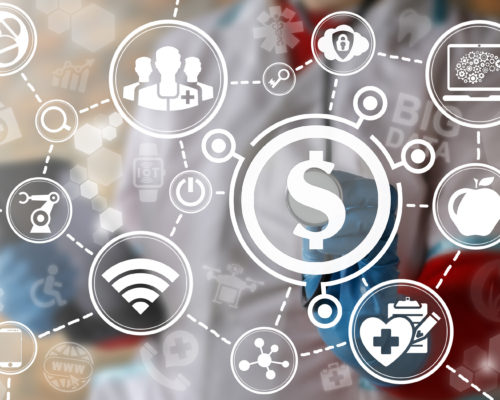Predictive analytics and predictive modeling can be used for several different applications in healthcare, including measuring the risk of adverse events and predicting patient outcomes. Today we’ll highlight what predictive analytics is and how we’ll see it benefiting the healthcare industry in 2022 and beyond.
Table of Contents
What is Predictive Analytics?
Predictive analytics is a powerful predictive modeling technique that uses past data to help predict future events. Predictive models are built using machine learning, statistics, and probability theory to estimate the likelihood of an outcome or event without actually having any knowledge about it yet.
The healthcare industry is essentially made of data. There is data and statistics for decades upon decades of healthcare research, disease, treatments plans, cures, and more. Predictive analytics may help to manage population health, financial success, and better outcomes throughout the industry using that data.
How Does Healthcare Use Predictive Analytics?
Predictive analytics has many benefits for patients and the betterment of care delivery within hospitals and clinics across different regions globally. Here are just a few ways predictive modeling will benefit consumers moving into 2022:
Identifying Hospitalizations Before they Happen
Predictive analytics can predict the patient’s risk of hospitalization before it happens. Today, the healthcare industry uses this kind of predictive modeling to prevent unnecessary readmissions and costly events that could have been avoided if a predictive model was put into place earlier on.
Detecting Disease Risk & Prescription Drug Usage Trends
Predictive modeling can also be used to find the most predictive variables that contribute to disease risk. In addition, patients with certain conditions may benefit from predictive analytics, as it can help healthcare providers pinpoint what might cause or prevent them from succumbing to their condition.
Predictive analytics can also track prescription drug usage trends by following patients throughout the cycle of their treatment and better plan for which prescriptions are effective in treating certain diseases. As a result, it saves a ton of time and money for both providers and patients who struggle to find the right combination of meds that work.
Predicting Patient Outcomes Based on Treatment Plans
Predictive analytics may also be able to help predict patient outcomes based on their treatment plan. However, for predictive models to work, many different variables must be collected from patients and analyzed concerning their health status over time.
Detecting Fraud in Healthcare Claims Processing
Fraud is a huge issue in healthcare, particularly insurance claims. Luckily these analytics can also be used to detect fraud in healthcare claims processing. These models can identify certain predictive variables that may indicate fraudulent behavior, which is especially helpful in claims processing where one fraudulent event can stall the entire process and take valuable time and money away from non-fraudulent cases.
Risk Scoring for Chronic Conditions
Every person eligible for health insurance receives a risk score. These scores determine what level of risk they bring and can affect which insurance companies will cover them and for how much cost. Basically, it solidifies how much an insurance provider will be reimbursed for paying for expensive patients with chronic conditions or other high-risk diseases.
Predictive analytics can help with this by identifying variables that contribute to risk for a specific disease. Then healthcare providers are able to assume risk scores based on those predictive variables. This allows insurance companies to better understand which patients should be covered and how many high-risk enrollees to expect every year.
Prevent Readmissions to Hospitals
If patients are discharged from a hospital but return within 30 days and are readmitted due to complications or no improvement in their condition, hospitals can get charged hefty fines. So prevention is vital to avoid any 30-day readmissions.
Analytics software that can identify patients with characteristics that have a significant impact on readmission rates might assist hospitals in determining when to focus resources on follow-up and how to design discharge planning methods to avoid early returns.
Knowing How to Treat Common Diseases
Extensive collections of data can help predict the best course of treatment for common diseases. For example, specific treatments and medications may appear more effective than others in treating a disease based on the characteristics they have identified as predictive variables over time with these patients.
Improving Data Security
As predictive analytics becomes more widely implemented in healthcare, it will also become increasingly important to protect patient data. These predictive models often require large amounts of information that must be stored securely and only accessed by authorized users.
AI can help determine any risky behavior like hackers or fraudulent actions. It can also be utilized to decrease human error by scanning important documents and forms digitally via AI and machine learning. This move continues to be a game-changer when it comes to data accuracy and security.
Budget and Supply Chain Planning
Analytics is essential to predicting annual budgets and supply chain management. These predictive models allow healthcare providers to predict future costs based on the volume of patients, new technologies, types of treatment administered, or any other factors that contribute to those expenses. This can minimize budget constraints by allowing hospitals and insurance companies alike sufficient time for financial planning.
Better Access to Care through Reduced Wait Times & Expenses
This is primarily due to models that can predict future events before they happen so that treatment plans may be adjusted accordingly or preventative measures are taken. Because predictive analytics allows us to identify diseases early on, it also means less invasive treatment methods may be used, leading to faster recovery times with fewer associated risks. And because this technology reduces wait times by pinpointing patient needs, predictive analytics can also help health insurance companies save time and money on staff planning.
With the ever-increasing need for healthcare services, predictive analytics will be essential to determining risk and predicting patient outcomes. Healthcare providers are already using predictive analytics in their work; by 2022, we’ll see even more benefits of this technology as it becomes more of a standard procedure.
To stay up to date on healthcare industry news and tips on how to better manage your diabetes, check out our blog! And if you ever want to integrate innovative technologies into your daily diabetes management, reach out to us today!













